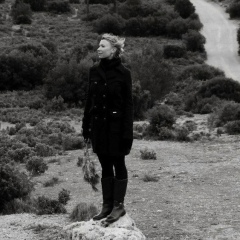Я посмотрела в Манеже "Хранить вечно": http://www.manege.spb.ru/events/muzejno-teatralnyj-proekt-hranit-vechno/ - и теперь считаю, все, независимо от пола, возраста, рода занятий и отношению к музеям должны всё бросить и бежать туда, пока не закрылось, а оно только до 8 октября. Потому что это реально за последние годы самое сильное впечатление - хотя я, по роду деятельности и по склонности души, впечатлениями довольно пресыщена.
Вкратце: "театрально-выставочный проект" это ты заходишь, тебе дают аудиогид с голосом Алисы Фрейндлих, и ты часа полтора-два идёшь сквозь пространство и время, раскрывая судьбу наших пригородных музеев: Пушкина, Павловска, Гатичны и Петергофа в 20 веке - от национализации во время Революции и разрушения во время Великой Отечественной. Для тех, кто не в теме: сам по себе факт, что в результате Революции, которая, как известно, была направлена против "проклятого царизма" бывшие императорские дома, полные золота и бесценного искусства, не разграбили и сожгли, а превратили в музеи - уже удивительно. А дальше начинаются факты уже не столь известные широкой публике: как в эпоху "великой индустриализации" начались "музейные распродажи", когда советское правительство совершенно официально продало за рубеж десятки тысяч предметов искусства, чтобы покрыть валютный дефицит - и что из этого вышло. И как во время репрессий тридцатых годов среди прочих "врагов народа" сгинули десятки музейщиков. И самое страшное, 1941-1944. Когда то, что удалось вывести до наступления немцев - мебель, картины, бронза, фарфор, было свезено в Ленинград и хранилось в Исаакиевском соборе, составленное в штабеля деревянных ящиков в центральном зале бывшего храма. А в подвале жили сотрудники - около ста человек, так называемое "Объединённое музейное хозяйство". Во главе с Анной Ивановной Зеленовой, о которой я не раз уже писала посты. Музейщими - по блокадным нормативам - "служащие", то есть те, кому в самые тяжёлые недели полагались те самые "125 блокадных грамм с огнём и кровью пополам", смогли не только спасти тысячи экспонатов, когда во время , ежедневных дежурств в промерзавшем насквозь соборе разбирали штабеля отсыревших ящиков и вытаскивали вещи, чтобы высушить их хоть на солнце, пусть и в 25-градусный мороз. Там, в подвалах Исаакия по настоянию Зеленовой началась самая важная работа - подготовка к реставрации дворцов. Посреди голода, холода, бомбёжек и смерти, процарапанные при свете коптилок перьями с замёрзшими чернилами по жёлтым страницам - рождались планы возрождения из пепла золочёных залов и обитых шёлком гостиных бывших императорских дворцов. Дворцов, которые в то время стояли разграбленными скелетами, или уже сгорели, оставив груду руин.
Выставка просто нереально мощная по эмоциональному воздействию. Задействовано не так много средств: свет, цвет, вещи, которые предоставили музеи, и голос Алисы Бруновны, который зачитывает отрывки из дневника Ольги Д. Она родилась в семье дореволюционного служащего Александровского дворца, который после 1917 участвовал в превращении дворцов в музеи, а в тридцатые - был казнён, сама стала со временем экскурсоводом в Петергофе и в 1941-44 была в Исаакие, в ОМХ. Ты проходишь через несколько небольших "пространств" - стилизованных под комнаты, другие - вагоны, третьи - будто кусок парка - и перед тобой последовательно разворачивается история каждой из эпох, уложившихся в короткий двадцатый век.
Не могу удержаться от замечания, что выставка любопытна ещё и тем, что демонстрирует не только и не столько "как было", но то, как это выглядело для отдельно взятого человека, который, тем не менее, представляет собой целую среду - и этот взгляд воссоздан представителями этой самой среды, вернее - её нынешним поколением. Короче, это познавательно не только с точки зрения истории первой половины 20 столетия, но и с точки зрения реальности, или, как сейчас модно говорить, социокультурных реалий сегодняшнего дня, когда мы, по ходу, переживаем очередную драму - хотелось бы надеяться, что не трагедию - вечного конфликта "культуры и широких масс"
Огорчает только то, что проект работает только две недели и только на русском языке. Моё личное мнение - сделать аудиогиды на всех языках и оставить на летний сезон, хоть в вечернее время, наших дорогих туристов после прогулок по музеям туда запускать - это будет круче, чем Эрмитаж. Так-то мы, конечно, это всё рассказываем в общих чертах и на фотографиях показываем, но то ли дело пройти всё самому и прочувствовать хоть чуть-чуть "на своей шкуре".
Вкратце: "театрально-выставочный проект" это ты заходишь, тебе дают аудиогид с голосом Алисы Фрейндлих, и ты часа полтора-два идёшь сквозь пространство и время, раскрывая судьбу наших пригородных музеев: Пушкина, Павловска, Гатичны и Петергофа в 20 веке - от национализации во время Революции и разрушения во время Великой Отечественной. Для тех, кто не в теме: сам по себе факт, что в результате Революции, которая, как известно, была направлена против "проклятого царизма" бывшие императорские дома, полные золота и бесценного искусства, не разграбили и сожгли, а превратили в музеи - уже удивительно. А дальше начинаются факты уже не столь известные широкой публике: как в эпоху "великой индустриализации" начались "музейные распродажи", когда советское правительство совершенно официально продало за рубеж десятки тысяч предметов искусства, чтобы покрыть валютный дефицит - и что из этого вышло. И как во время репрессий тридцатых годов среди прочих "врагов народа" сгинули десятки музейщиков. И самое страшное, 1941-1944. Когда то, что удалось вывести до наступления немцев - мебель, картины, бронза, фарфор, было свезено в Ленинград и хранилось в Исаакиевском соборе, составленное в штабеля деревянных ящиков в центральном зале бывшего храма. А в подвале жили сотрудники - около ста человек, так называемое "Объединённое музейное хозяйство". Во главе с Анной Ивановной Зеленовой, о которой я не раз уже писала посты. Музейщими - по блокадным нормативам - "служащие", то есть те, кому в самые тяжёлые недели полагались те самые "125 блокадных грамм с огнём и кровью пополам", смогли не только спасти тысячи экспонатов, когда во время , ежедневных дежурств в промерзавшем насквозь соборе разбирали штабеля отсыревших ящиков и вытаскивали вещи, чтобы высушить их хоть на солнце, пусть и в 25-градусный мороз. Там, в подвалах Исаакия по настоянию Зеленовой началась самая важная работа - подготовка к реставрации дворцов. Посреди голода, холода, бомбёжек и смерти, процарапанные при свете коптилок перьями с замёрзшими чернилами по жёлтым страницам - рождались планы возрождения из пепла золочёных залов и обитых шёлком гостиных бывших императорских дворцов. Дворцов, которые в то время стояли разграбленными скелетами, или уже сгорели, оставив груду руин.
Выставка просто нереально мощная по эмоциональному воздействию. Задействовано не так много средств: свет, цвет, вещи, которые предоставили музеи, и голос Алисы Бруновны, который зачитывает отрывки из дневника Ольги Д. Она родилась в семье дореволюционного служащего Александровского дворца, который после 1917 участвовал в превращении дворцов в музеи, а в тридцатые - был казнён, сама стала со временем экскурсоводом в Петергофе и в 1941-44 была в Исаакие, в ОМХ. Ты проходишь через несколько небольших "пространств" - стилизованных под комнаты, другие - вагоны, третьи - будто кусок парка - и перед тобой последовательно разворачивается история каждой из эпох, уложившихся в короткий двадцатый век.
Не могу удержаться от замечания, что выставка любопытна ещё и тем, что демонстрирует не только и не столько "как было", но то, как это выглядело для отдельно взятого человека, который, тем не менее, представляет собой целую среду - и этот взгляд воссоздан представителями этой самой среды, вернее - её нынешним поколением. Короче, это познавательно не только с точки зрения истории первой половины 20 столетия, но и с точки зрения реальности, или, как сейчас модно говорить, социокультурных реалий сегодняшнего дня, когда мы, по ходу, переживаем очередную драму - хотелось бы надеяться, что не трагедию - вечного конфликта "культуры и широких масс"
Огорчает только то, что проект работает только две недели и только на русском языке. Моё личное мнение - сделать аудиогиды на всех языках и оставить на летний сезон, хоть в вечернее время, наших дорогих туристов после прогулок по музеям туда запускать - это будет круче, чем Эрмитаж. Так-то мы, конечно, это всё рассказываем в общих чертах и на фотографиях показываем, но то ли дело пройти всё самому и прочувствовать хоть чуть-чуть "на своей шкуре".
I looked in the Manege “Keep forever”: http://www.manege.spb.ru/events/muzejno-teatralnyj-proekt-hranit-vechno/ - and now I consider everything, regardless of gender, age, occupation and attitude to museums they should drop everything and run there until it is closed, and it is only until October 8th. Because this is real in recent years, the strongest impression - although I, by the nature of my activity and the inclination of my soul, am quite saturated with impressions.
In short: the “theater and exhibition project” you come in, they give you an audio guide with the voice of Alice Freindlich, and you walk through space and time for an hour and a half or two, revealing the fate of our suburban museums: Pushkin, Pavlovsk, Gatichny and Peterhof in the 20th century - from nationalization during the Revolution and destruction during the Great Patriotic War. For those who are not on the topic: the fact in itself that as a result of the Revolution, which, as you know, was directed against the “damned tsarism”, former imperial houses full of gold and priceless art, was not plundered and burned, but turned into museums - already amazing. And then the facts begin, which are already not so well-known to the general public: how “museum sales” began in the era of “great industrialization”, when the Soviet government completely officially sold tens of thousands of art objects abroad to cover the currency deficit - and what came of it. And as during the repressions of the thirties, among other "enemies of the people" dozens of museum workers perished. And the worst thing, 1941-1944. When what managed to be brought out before the German offensive - furniture, paintings, bronze, porcelain, was brought to Leningrad and stored in St. Isaac's Cathedral, composed in stacks of wooden boxes in the central hall of the former church. And in the basement there were employees - about a hundred people, the so-called "United Museum Economy". Led by Anna Ivanovna Zelenova, about whom I have already written posts more than once. Museum workers - according to the blockade standards - "employees", that is, those who in the most difficult weeks were supposed to use the same "125 blockade grams with fire and blood in half", could not only save thousands of artifacts when, during daily shifts on duty in the cathedral frozen through they sorted stacks of damp boxes and pulled out things to dry them even in the sun, even in 25-degree frost. There, in the basements of Isaac, at the insistence of Zelenova, the most important work began - preparing for the restoration of the palaces. In the midst of hunger, cold, bombing and death, the smoke-scratched feathers with frozen ink on the yellow pages - plans for the revival of the gilded halls and the silk-laden living rooms of the former imperial palaces were born. The palaces, which at that time were looted by skeletons, or were already burned, leaving a pile of ruins.
The exhibition is simply unrealistically powerful in terms of emotional impact. Not so many funds were involved: the light, color, things that the museums provided, and Alice Brunovna’s voice, which reads excerpts from Olga D.’s diary. She was born in the family of a pre-revolutionary employee of the Alexander Palace, which after 1917 participated in the transformation of palaces into museums, and the thirties - he was executed, she herself became a tour guide in Peterhof over time and in 1941-44 she was in Isaac, in OMX. You go through several small "spaces" - styled as rooms, others - cars, others - like a piece of a park - and the story of each epoch that fit into the short twentieth century unfolds before you.
I can’t refrain from remarking that the exhibition is also interesting in that it shows not only and not so much “as it was”, but how it looked for a single person, who, nevertheless, represents a whole environment - and this view recreated by representatives of this very environment, or rather, by its current generation. In short, this is cognitive not only from the point of view of the history of the first half of the 20th century, but also from the point of view of reality, or, as it is now fashionable to say, the sociocultural realities of today, when we, along the way, experience another drama - I would like to hope that tragedy - the eternal conflict of "culture and the masses"
The only sad thing is that the project only works for two weeks and only in Russian. My personal opinion is to make audio guides in all languages and leave it for the summer season, even in the evening, to launch our dear tourists after walking through museums - it will be cooler than the Hermitage. So we, of course, tell it all in general terms and show in the photographs, but whether it’s a matter of going through everything ourselves and feeling at least a little “on our own skin”.
In short: the “theater and exhibition project” you come in, they give you an audio guide with the voice of Alice Freindlich, and you walk through space and time for an hour and a half or two, revealing the fate of our suburban museums: Pushkin, Pavlovsk, Gatichny and Peterhof in the 20th century - from nationalization during the Revolution and destruction during the Great Patriotic War. For those who are not on the topic: the fact in itself that as a result of the Revolution, which, as you know, was directed against the “damned tsarism”, former imperial houses full of gold and priceless art, was not plundered and burned, but turned into museums - already amazing. And then the facts begin, which are already not so well-known to the general public: how “museum sales” began in the era of “great industrialization”, when the Soviet government completely officially sold tens of thousands of art objects abroad to cover the currency deficit - and what came of it. And as during the repressions of the thirties, among other "enemies of the people" dozens of museum workers perished. And the worst thing, 1941-1944. When what managed to be brought out before the German offensive - furniture, paintings, bronze, porcelain, was brought to Leningrad and stored in St. Isaac's Cathedral, composed in stacks of wooden boxes in the central hall of the former church. And in the basement there were employees - about a hundred people, the so-called "United Museum Economy". Led by Anna Ivanovna Zelenova, about whom I have already written posts more than once. Museum workers - according to the blockade standards - "employees", that is, those who in the most difficult weeks were supposed to use the same "125 blockade grams with fire and blood in half", could not only save thousands of artifacts when, during daily shifts on duty in the cathedral frozen through they sorted stacks of damp boxes and pulled out things to dry them even in the sun, even in 25-degree frost. There, in the basements of Isaac, at the insistence of Zelenova, the most important work began - preparing for the restoration of the palaces. In the midst of hunger, cold, bombing and death, the smoke-scratched feathers with frozen ink on the yellow pages - plans for the revival of the gilded halls and the silk-laden living rooms of the former imperial palaces were born. The palaces, which at that time were looted by skeletons, or were already burned, leaving a pile of ruins.
The exhibition is simply unrealistically powerful in terms of emotional impact. Not so many funds were involved: the light, color, things that the museums provided, and Alice Brunovna’s voice, which reads excerpts from Olga D.’s diary. She was born in the family of a pre-revolutionary employee of the Alexander Palace, which after 1917 participated in the transformation of palaces into museums, and the thirties - he was executed, she herself became a tour guide in Peterhof over time and in 1941-44 she was in Isaac, in OMX. You go through several small "spaces" - styled as rooms, others - cars, others - like a piece of a park - and the story of each epoch that fit into the short twentieth century unfolds before you.
I can’t refrain from remarking that the exhibition is also interesting in that it shows not only and not so much “as it was”, but how it looked for a single person, who, nevertheless, represents a whole environment - and this view recreated by representatives of this very environment, or rather, by its current generation. In short, this is cognitive not only from the point of view of the history of the first half of the 20th century, but also from the point of view of reality, or, as it is now fashionable to say, the sociocultural realities of today, when we, along the way, experience another drama - I would like to hope that tragedy - the eternal conflict of "culture and the masses"
The only sad thing is that the project only works for two weeks and only in Russian. My personal opinion is to make audio guides in all languages and leave it for the summer season, even in the evening, to launch our dear tourists after walking through museums - it will be cooler than the Hermitage. So we, of course, tell it all in general terms and show in the photographs, but whether it’s a matter of going through everything ourselves and feeling at least a little “on our own skin”.





У записи 48 лайков,
10 репостов,
1478 просмотров.
10 репостов,
1478 просмотров.
Эту запись оставил(а) на своей стене Александра Маяк


































































